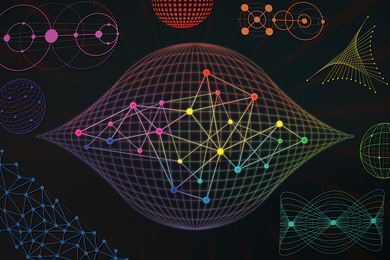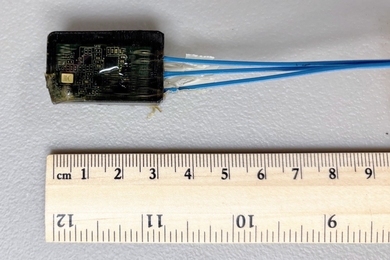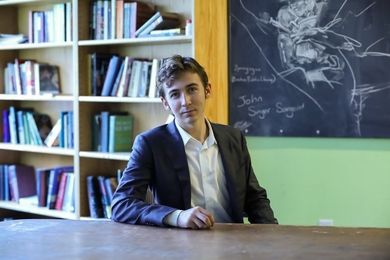Professor June L. Matthews of the Department of Physics has been named director of the Laboratory for Nuclear Science (LNS). Home of two Nobel laureates, LNS is MIT's center for experimental and theoretical research in nuclear and particle physics.
Since joining the MIT faculty in 1973, Professor Matthews has been active in both undergraduate and graduate teaching and served as academic officer in the Department of Physics from 1994 to 1998.
In her research, Professor Matthews has used beams of gamma-rays, pi-mesons and neutrons to probe the strong interactions among the constituents of the atomic nucleus. She is a principal in the Bates Large Acceptance Spectrometer Toroid (BLAST) project currently under construction at the MIT-Bates Linear Accelerator Center in Middleton, MA.
In BLAST, which is unique in the world, spin-polarized electrons will interact with polarized targets in experiments that probe the basic structure of matter.
Professor Matthews also works at the Los Alamos Neutron Science Center at the Los Alamos (NM) National Laboratory, studying reactions in which neutrons interact with protons, including the process through which the particles stick together as the simplest nucleus, the deuteron. This experiment is expected to help test models of how nuclei were formed following the Big Bang.
In an interview with Deborah Halber of MIT Tech Talk, Professor Matthews discussed her decision to go into nuclear physics and what she hopes to accomplish as director of the LNS.
Halber: LNS is the largest university laboratory of its kind in the nation. What led MIT to invest in this entity, initially and over time?
Matthews: The Laboratory for Nuclear Science and Engineering, as it was called originally, was formed in 1946 with support from the Office of Naval Research "to provide facilities for cooperative research and education in the fields of nuclear science and atomic power."
World War II and the Manhattan Project had concluded. Nuclear physics and the newer field of high energy (or elementary particle) physics were undergoing a period of rapid growth, owing to new technologies such as particle accelerators and electronics and to new theoretical discoveries.
MIT owes much to the vision of the scientists and engineers at the time in the departments of chemistry, physics, metallurgy, biology, chemical engineering, electrical engineering and mechanical engineering who recognized the enormous opportunities in these fields and realized the potential advantages of a cooperative effort.
Although the mission of LNS has evolved with the science, and the scale and the costs of the experimental apparatus have risen proportionately, I believe that MIT continues to recognize that a large cooperative laboratory of this nature provides the most effective means of operating at the frontiers of research while also pursuing MIT's educational objectives.
������
What do you hope to see LNS accomplish during your tenure as director?
My overall highest priorities as director of LNS are to support the highest quality research in nuclear and particle physics, to nurture the careers of young researchers in these fields and to highlight the importance of university-based research.
My specific goals are to ensure a healthy future for the MIT-Bates Accelerator Center, to ensure that MIT physicists play a leading role in the Large Hadron Collider project at CERN and to cooperate with MIT's physics department in providing the best possible education for undergraduate and graduate students in nuclear and particle physics.
������
As director, will you still teach?
No, I won't be teaching, at least not any regular classes. The position is supposed to be approximately 50 percent administration, 50 percent research, so administration will take up the "half" of the time that I would spend on teaching. However, I still intend to supervise graduate students and will perhaps in the future teach a freshman advisor seminar. Three years ago, I taught a seminar on "Physics and Music" and enjoyed it immensely.
������
Is it hard to explain to people what you do for a living?
I've always enjoyed talking to nonscientists in social and other situations! In explaining what I do, I emphasize my role as an educator and speak in general terms about performing basic research into the fundamental structure of matter. When asked about possible practical applications, I'll say that the "purpose" of my work is to contribute to the store of human knowledge and understanding of the universe in which we live.
������
Why is it that by studying the tiniest forms of matter we may be able to understand the creation of the entire universe?
We believe that all matter is made up of a small number of elementary building blocks, held together and interacting by only four fundamental forces: gravitation, electromagnetism and the strong and weak nuclear forces. We believe that the universe began with the Big Bang, followed by expansion and differentiation into the particles and interactions that we see today.
In nuclear and particle physics we "take apart" matter into its elementary constituents with the aim of understanding how it was put together in the first place.
������
How or when did you first become interested in nuclear physics?
I think that my first serious interests in science arose during my middle-school years and were in natural history (to this day I have an abiding love of nature) and astronomy. My grandfather, Harlow Shapley, was a well-known astronomer and long-time director of the Harvard Observatory. In addition, I had a very inspirational high school mathematics teacher. I was strongly encouraged by my parents, as well as by my teachers, to follow these interests.
I decided to major in physics in college as a good background for a possible future career in astronomy or astrophysics. Although I enjoyed mathematics, I enjoyed "getting my hands dirty" even more, and decided to pursue experimental physics. I did a senior research project in nuclear physics, which led me to want to learn more about this subfield in graduate school. At MIT, I took a graduate course in nuclear physics from Professor Lee Grodzins, joined the research group of Professor William Bertozzi and never looked back! [Professor Matthews received the PhD degree in physics from MIT in 1967.]
������
Was it challenging to choose a field that attracted few women? Why do women tend to gravitate to other scientific fields more than to physics?
I never really thought very much about the paucity of women in physics; why should there be an equal number of men and women in all endeavors?
In college and graduate school, although women were a minority in physics, I had plenty of women friends in other fields, such as biology, chemistry and the humanities. In some activities in which I participated, men were in the minority.
The question of why there are so few women in physics is a complicated one -- there is certainly no simple answer -- and is an issue that many people have studied. I am no expert, but I have been told, and have observed, to some extent, that in early education in science both boys and girls participate with equal enthusiasm and equal spirit of enquiry. The differentiation begins to appear in the middle-school years, when parents and teachers begin to expect different things of boys and girls. Traditional male/female stereotypes begin to play a more important role.
I was lucky in that I was encouraged to pursue a variety of interests; all my parents expected of me and my siblings was that we would achieve, to the best of our abilities, in whatever we were interested in.
It is true that physics is a rigorous, analytical science, and a career as a physicist is a demanding one. The physics major at MIT is perceived as being one of the most difficult courses. But I, for one, have enjoyed the challenge and will continue to do so in my new position.
A version of this article appeared in MIT Tech Talk on September 20, 2000.






